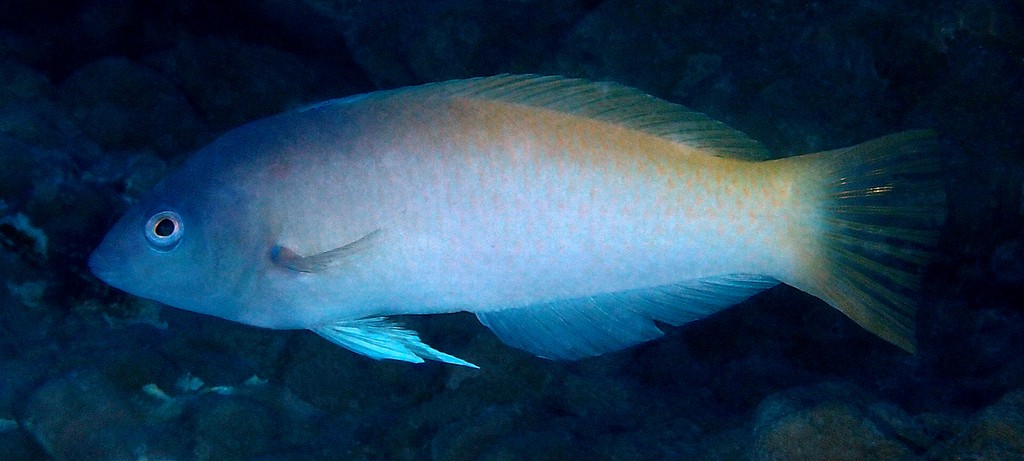HALICHOERES PROSOPEION - (BLEEKER, 1853)
Actinopterygii (Gigaclass) > Actinopteri (Class) > Teleostei (Subclass) > Labriformes (Order) > Labroidei (Suborder) > Labridae (Family) > Halichoeres (Genus)
Labre bicolore, Half-grey wrasse, Two-tone wrasse, Twotone Wrasse, Munatenbera-damashi, ムナテンベラダマシ, 云纹海猪鱼, 雲紋海豬魚,
Synonymes
Halichoeres prosopein (Bleeker, 1853)
Halichoeris prosopeion (Bleeker, 1853)
Julis prosopeion (Bleeker, 1853)
----------------------
Description
Dorsal spines (total): 9; Dorsal soft rays (total): 12-13; Anal spines: 3; Anal soft rays: 12; Pectoral fin rays: 13-14 (Usually: 14); Lateral line scales: 27, the lateral line scales with 1-3 pores, lateral line continuous. Vertebrae: 25. Head naked; Two pairs of large canine teeth at front of upper jaw, the second pair curved, and one pair at front of lower jaw; Anterior dorsal and anal soft rays longer than posterior rays; Pelvic fins of males and large females very long, reaching posterior to anus, often to or beyond origin of anal fin. Caudal fin of adults truncate. Max. length: 13.0 cm SL. Depth range: 2 - 40 m.
Color
Anterior head and body color of adults in life bluish gray, shading posteriorly to yellowish; Scales often with orange-yellow vertical lines; A dark spot posterior to dorsal half of eye; Dorsal fin with a large black spot edged with blue. Juveniles with 4 black stripes on head and body.
Etymology
Halichoeres: from Greek, halio-, hali-, halo-, hal- = word-forming element meaning "salt, sea," a Greek combination form of hals (genitive halos) "a lump of salt, salt generally," in Homer, "the sea," + from Greek, choiros = pig. Referring to elongated conical tooth at each corner of mouth, pointed outwards and forwards, and usually protruding beyond the flesh of lips, which reminded Rüppell of the canine teeth of a boar; Here "hog of the sea or hogfish".
prosopeion: from Latin, prosopeion or peosopis = a Greek theatre mask. Allusion not explained.
Original description: Julis prosopeion Bleeker, 1853 - Type locality: Ambon Island, Molucca Islands, Indonesia.
Distribution
Eastern Indian Ocean, western Pacific: Indonesia, east to Samoa, north to Japan, south to northern Australia and New Caledonia.
Biology
Inhabits lagoon and seaward reefs, in coral-rich areas. Also found along drop-offs on the bottom of large caves. Usually seen solitary. Distinct pairing during breeding. Aquarium fish.
Last update: 29, September 2024
Labre bicolore, Half-grey wrasse, Two-tone wrasse, Twotone Wrasse, Munatenbera-damashi, ムナテンベラダマシ, 云纹海猪鱼, 雲紋海豬魚,
Synonymes
Halichoeres prosopein (Bleeker, 1853)
Halichoeris prosopeion (Bleeker, 1853)
Julis prosopeion (Bleeker, 1853)
----------------------
Description
Dorsal spines (total): 9; Dorsal soft rays (total): 12-13; Anal spines: 3; Anal soft rays: 12; Pectoral fin rays: 13-14 (Usually: 14); Lateral line scales: 27, the lateral line scales with 1-3 pores, lateral line continuous. Vertebrae: 25. Head naked; Two pairs of large canine teeth at front of upper jaw, the second pair curved, and one pair at front of lower jaw; Anterior dorsal and anal soft rays longer than posterior rays; Pelvic fins of males and large females very long, reaching posterior to anus, often to or beyond origin of anal fin. Caudal fin of adults truncate. Max. length: 13.0 cm SL. Depth range: 2 - 40 m.
Color
Anterior head and body color of adults in life bluish gray, shading posteriorly to yellowish; Scales often with orange-yellow vertical lines; A dark spot posterior to dorsal half of eye; Dorsal fin with a large black spot edged with blue. Juveniles with 4 black stripes on head and body.
Etymology
Halichoeres: from Greek, halio-, hali-, halo-, hal- = word-forming element meaning "salt, sea," a Greek combination form of hals (genitive halos) "a lump of salt, salt generally," in Homer, "the sea," + from Greek, choiros = pig. Referring to elongated conical tooth at each corner of mouth, pointed outwards and forwards, and usually protruding beyond the flesh of lips, which reminded Rüppell of the canine teeth of a boar; Here "hog of the sea or hogfish".
prosopeion: from Latin, prosopeion or peosopis = a Greek theatre mask. Allusion not explained.
Original description: Julis prosopeion Bleeker, 1853 - Type locality: Ambon Island, Molucca Islands, Indonesia.
Distribution
Eastern Indian Ocean, western Pacific: Indonesia, east to Samoa, north to Japan, south to northern Australia and New Caledonia.
Biology
Inhabits lagoon and seaward reefs, in coral-rich areas. Also found along drop-offs on the bottom of large caves. Usually seen solitary. Distinct pairing during breeding. Aquarium fish.
Last update: 29, September 2024
